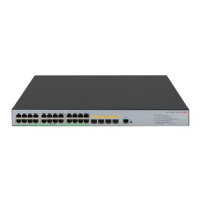42
Total 1 IP Group(s).
Total 1 IP Source(s).
Total 1 MAC Group(s).
Port flags: D-Dynamic port, S-Static port, C-Copy port, P-PIM port
Subvlan flags: R-Real VLAN, C-Copy VLAN
Vlan(id):100.
Total 1 IP Group(s).
Total 1 IP Source(s).
Total 1 MAC Group(s).
Router port(s):total 1 port.
GE1/0/1 (D) ( 00:01:30 )
IP group(s):the following ip group(s) match to one mac group.
IP group address:224.1.1.1
(0.0.0.0, 224.1.1.1):
Attribute: Host Port
Host port(s):total 2 port.
GE1/0/3 (D) ( 00:03:23 )
GE1/0/4 (D) ( 00:04:10 )
MAC group(s):
MAC group address:0100-5e01-0101
Host port(s):total 2 port.
GE1/0/3
GE1/0/4
The output shows that GigabitEthernet 1/0/3 and GigabitEthernet 1/0/4 of Switch A has joined
m u l t i c a s t g r o u p 224 .1.1.1.
Static port configuration example
Network requirements
As shown in Figure 15, IGMPv2 runs on Router A, and IGMPv2 snooping runs on Switch A, Switch B,
and Switch C. Router A acts as the IGMP querier.
Host A and host C are permanent receivers of multicast group 224.1.1.1. GigabitEthernet 1/0/3 and
GigabitEthernet 1/0/5 on Switch C are required to be configured as static member ports for multicast
group 224.1.1.1 to enhance the reliability of multicast traffic transmission.
Suppose STP runs on the network. To avoid data loops, the forwarding path from Switch A to Switch C
is blocked under normal conditions, and multicast traffic flows to the receivers attached to Switch C only
along the path of Switch A—Switch B—Switch C.
Configure GigabitEthernet 1/0/3 on Switch A as a static router port, so that multicast traffic can flow to
the receivers nearly uninterruptedly along the path of Switch A—Switch C in the case that the path of
Switch A—Switch B—Switch C gets blocked.
For more information about the Spanning Tree Protocol (STP), see Layer 2—LAN Switching Configuration
Guide.

